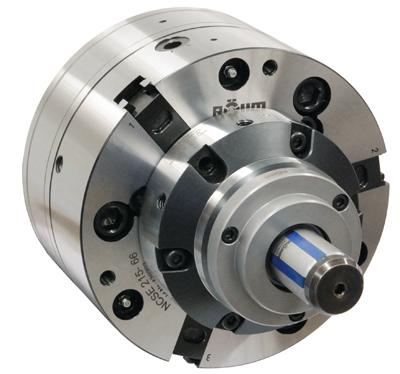
The DURO-NCSE Flex power chuck from Röhm Products of America provides a quick and simple way to change out jaws and clamping tools.
Especially beneficial to those shops needing frequent clamping tool changes, the power chuck system allows them to switch from mandrels to collet chucks to face drivers and centers without having to the remove the power chuck from the machine tool. Plus, the DURO-NCSE Flex is ideal for short-bar-feeding applications in that it adds increased workpiece support at the machine tool spindle.
In use, the DURO-NCSE Flex works as a standard three-jaw chuck. And because the system features a special bayonet-style connection, shops change only an attachment system to switch clamping devices, such as for one part-machining operation to the next.
The DURO-NCSE Flex, in short, 4'-bar-feeding applications, reduces the amount of prep cutting needed as well as material waste. As opposed to cutting 12'-long bar stock three times in 3' lengths and ending up with four pieces of unusable remnant stock, the DURO-NCSE with an added dead-length collet chuck generates more support for longer 4' sections. Thus, shops cut bars only twice and end up with one less piece of remnant.
At the base of the DURO-NCSE Flex system series is a case hardened steel chuck that features individual unlocking jaws for easily moving, changing and turning them. High accuracy holding and precision gripping ensures dependable performance, especially in extremely high-speed applications. Other variations within the series include the DURONCSE Flex KZZT/KZZT-A collet chuck and DURO-NCSE Flex ABSIS mandrel models.
Both the KZZT/KZZT-A and the ABSIS configurations provide part deformation-sensitive workholding, especially for thin-walled parts, and allow for quick adjusting. The KZZT/KZZT-A secures parts radially on their O.D.s and accommodates round, hexagon and square bar stock with its full through hole, while the ABSIS clamps workpieces radially from their I.D.s using an expandable segment sleeve.
Contact Details
Related Glossary Terms
- centers
centers
Cone-shaped pins that support a workpiece by one or two ends during machining. The centers fit into holes drilled in the workpiece ends. Centers that turn with the workpiece are called “live” centers; those that do not are called “dead” centers.
- chuck
chuck
Workholding device that affixes to a mill, lathe or drill-press spindle. It holds a tool or workpiece by one end, allowing it to be rotated. May also be fitted to the machine table to hold a workpiece. Two or more adjustable jaws actually hold the tool or part. May be actuated manually, pneumatically, hydraulically or electrically. See collet.
- collet
collet
Flexible-sided device that secures a tool or workpiece. Similar in function to a chuck, but can accommodate only a narrow size range. Typically provides greater gripping force and precision than a chuck. See chuck.
- mandrel
mandrel
Workholder for turning that fits inside hollow workpieces. Types available include expanding, pin and threaded.
- turning
turning
Workpiece is held in a chuck, mounted on a face plate or secured between centers and rotated while a cutting tool, normally a single-point tool, is fed into it along its periphery or across its end or face. Takes the form of straight turning (cutting along the periphery of the workpiece); taper turning (creating a taper); step turning (turning different-size diameters on the same work); chamfering (beveling an edge or shoulder); facing (cutting on an end); turning threads (usually external but can be internal); roughing (high-volume metal removal); and finishing (final light cuts). Performed on lathes, turning centers, chucking machines, automatic screw machines and similar machines.
